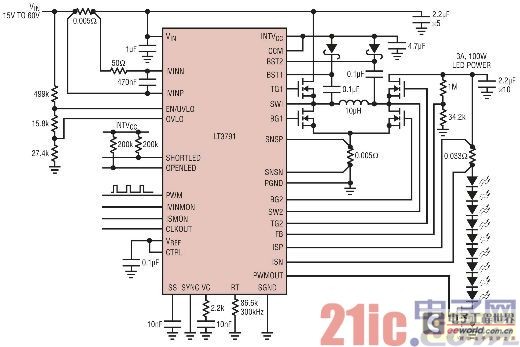background
An LED is a semiconductor device that emits incoherent narrow-spectrum light when a forward bias voltage is applied, thereby producing an electroluminescence phenomenon. In other words, a solid phosphor directly converts electrical energy into light under the action of an electric field. The color of the luminescence depends on the chemical composition of the semiconductor material used and may be close to ultraviolet, visible or infrared light.
LED technology has made great progress in the past few years. Improvements in heat dissipation, packaging, and process have resulted in higher brightness, higher efficiency, longer life, and lower cost. Unlike incandescent lamps, LEDs do not have a filament that burns out, and they tend to operate at lower temperatures. In addition, 95% of the energy of incandescent lamps is wasted in the form of heat.
The light output of high-power or high-brightness (HB) LEDs has exceeded the milestone of 100 lumens per watt (ie 100 lm/W). In fact, some manufacturers have announced that they have achieved 200 lm/W in the lab. So obviously, LEDs have surpassed incandescent lamps in terms of luminous efficacy (a typical 60W incandescent lamp has a light output of 15 lm/W). Or to put it another way, luminous effectiveness refers to the ratio of the light output of a light source (in lumens) to the power (in watts) consumed to produce that light output. Even so, it is expected that in the coming year, LEDs with 150 lm/W light output will be easily obtained in the market. Another benefit is the lifetime of the LED. Depending on the calculation method, white LED lamps have a lifespan of at least 50,000 hours, some even claim to be up to 100,000 hours, while incandescent lamps have a lifespan of only 1200 to 1500 hours.
The cost of high-brightness LED lighting is also rapidly declining. A few years ago, a single white light diode (several of these diodes made up of an LED and accounted for most of the cost of LED lights) cost about $4 and has now fallen to less than $1. Many analysts in the LED industry predict that the price of LED lamps replacing incandescent lamps will reach consumer acceptance in the coming year. Some LED manufacturers have announced that they have designed a light-emitting chip that produces LED light that is comparable to a 75W incandescent lamp, and that 75W incandescent lamps are common in most homes. This type of LED chip usually requires only about 9W of power to make the LED lamp produce the same light output as a 75W incandescent lamp.
Today, one of the key performance features that LED driver ICs must have is the ability to dim LEDs. Since the LED is driven with a constant current and the DC current value is proportional to the brightness of the LED, there are two ways to dim the LED current by changing the LED brightness. The first method is analog dimming, which reduces the DC current of the LED proportionally by reducing the constant LED current value. Reducing the LED current may cause a change in the color of the LED or result in inaccurate control of the LED current. The second method is digital or pulse width modulation (PWM) dimming. PWM dimming turns the LEDs on and off at a frequency equal to or higher than 100 Hz. Switching at such a frequency is not noticeable to the human eye. The duty cycle of the PWM dimming is proportional to the brightness of the LED, while the LED current remains the same value when turned on (as set by the LED driver IC), keeping the LED color constant at high dimming ratios. In some applications, this PWM dimming method can be used with dimming ratios up to 30,000:1.
Especially in the case of driving high-brightness (HB) LEDs, the LED driver IC must be able to provide enough for many different types of LED configurations in a conversion topology that satisfies both the input voltage range and the required output voltage and current requirements. Current and voltage. Therefore, in an ideal situation, a high-brightness LED driver IC should have the following characteristics:
Ø Wide input voltage range: up to 100V
Ø Wide output voltage range: up to 100V
Ø High efficiency conversion: up to 98%
Ø Strict adjustment of LED current matching: less than 2% change in temperature range
Ø Low noise, constant frequency operation: up to 2.5MHz
Ø Independent current and dimming control
Ø Wide dimming ratio: up to 30,000:1
Ø Multiple conversion topologies including buck, boost, buck-boost and SEPIC
Ø Many protection functions, such as protection of LED string open circuit, LED pin to VOUT short circuit, and accurate undervoltage lockout threshold
Ø Small and compact footprint solution requires minimal external components
High brightness LED example
There is no doubt that most car headlights are still incandescent. However, this dominance will be under pressure from high-intensity discharge (HID) lamps and high-brightness LED headlights. HID lamps include all high intensity discharge lamps used in general lighting, such as high pressure mercury vapor lamps, high pressure sodium lamps, low pressure sodium, etc. and metal halide lamps. Lighting the work or living environment, such as indoors, buildings or external spaces, the general lighting source is bright enough. Such lighting applications include residential lighting, commercial and industrial lighting, street lighting, and automotive headlights. HID xenon lamps were first introduced in automotive headlights in the 1990s. However, the production cost of such lamps is very high, so their use has been limited to high-end cars. In the future, the use of such HID xenon lamps will be rapidly reduced due to the recent introduction of high-brightness LEDs. Therefore, high-brightness LED headlamps will have the greatest growth in the next 10 years.
One of the biggest obstacles facing automotive lighting system designers is how to optimize all the features and benefits offered by this latest generation of LEDs. Because LEDs typically require an accurate and efficient current source and a dimming method, the LED driver IC must be designed to meet these requirements under a variety of operating conditions. In addition, the power solution for LED driver ICs must be efficient, rugged, and reliable, while still being extremely compact and cost effective.
It can be said that one of the most demanding applications for driving LEDs will be the automotive headlight system (composed of high beam, low beam, daytime running lights, fog lights and turn signals) because these lamps are both experienced The harsh automotive electrical environment must be adapted to a variety of temperature conditions. And they must always be placed in very limited spaces, always with an attractive cost structure.
New LED driver IC for automotive headlights
Linear Technology's recently introduced LT3791 is a synchronous four-switch buck-boost LED driver and regulator controller ideal for driving high-brightness LEDs for automotive headlamp applications. The controller operates over an input voltage range above, below or equal to the output voltage. The device features an input range of 4.5V to 60V and an output range of 0V to 60V, and seamless transition between operating modes. In addition, its unique synchronous buck-boost topology enables operating efficiency of up to 98%, which greatly reduces the size and weight of the heat sink necessary to dissipate the heat generated by power loss.
The ground-referenced voltage feedback pin (FB) is used as an input to several LED protection functions and allows the converter to operate as a constant voltage source, as shown in Figure 1. The device also provides fault protection to protect the LED from open or short circuit faults and to report fault conditions, while the timer allows the LT3791 to continue to run, lock, or restart when a fault occurs. The device also features a proprietary current mode topology and control architecture with a current sense resistor in buck and boost modes.

Figure 1: The LT3791 drives a 3A LED array with up to 100W of power
15V TO 60V: 15V to 60V
LED POWER: LED power supply
in conclusion
Although high-brightness LED drivers must have many of the performance characteristics, LEDs driven by such LED drivers must provide the necessary light output at the lowest power, so that there is no significant limit to thermal design. For designers of high-power, high-brightness LED products, fortunately, there are now both high-efficiency LEDs and high-performance LED drivers that drive these high-efficiency LEDs.
Gaming Headphones is a headset suitable for playing games. For game users, a game headset with excellent performance can allow players to experience the immersive feeling in the game. For competitive game players, the game headset can also assist game players and enhance combat effectiveness.
In the case of headphone use, we found that game use would be a large part of the demand, especially the need to use a pure headset to get better listening effect when both music and games are in use.
Compared with music headphones, Wired Game Headphones pay more attention to sound field and positioning sense (for example, shooting and shootout games need positioning), and the amount and intensity of low frequency are aggravated, so as to meet the user's experience of game sound effects. Music headphones, in essence, pay more attention to sound quality. The effect in the right range is super good, with pure sound quality and penetrating sound.
Among the many headsets, Wireless Gaming Headphone have the advantage of sensitivity. The relatively closed listening environment is also more conducive to game players to feel the details of the sound and improve their judgment of the sound. Therefore, compared with traditional headsets, gaming headsets have more advantages in positioning ability, can better express the sense of direction of sound, and are more suitable for 3D games to express sound clearly. In addition, player-oriented game headsets are often enhanced with low-frequency volume sensing to facilitate the game's plot and make it easier for players to immerse themselves in the game.

Gaming Headphones,Gaming Headset,Rgb Gaming Headphones,Gaming Bluetooth Earphones
Henan Yijiao Trading Co., Ltd , https://www.yijiaousb.com